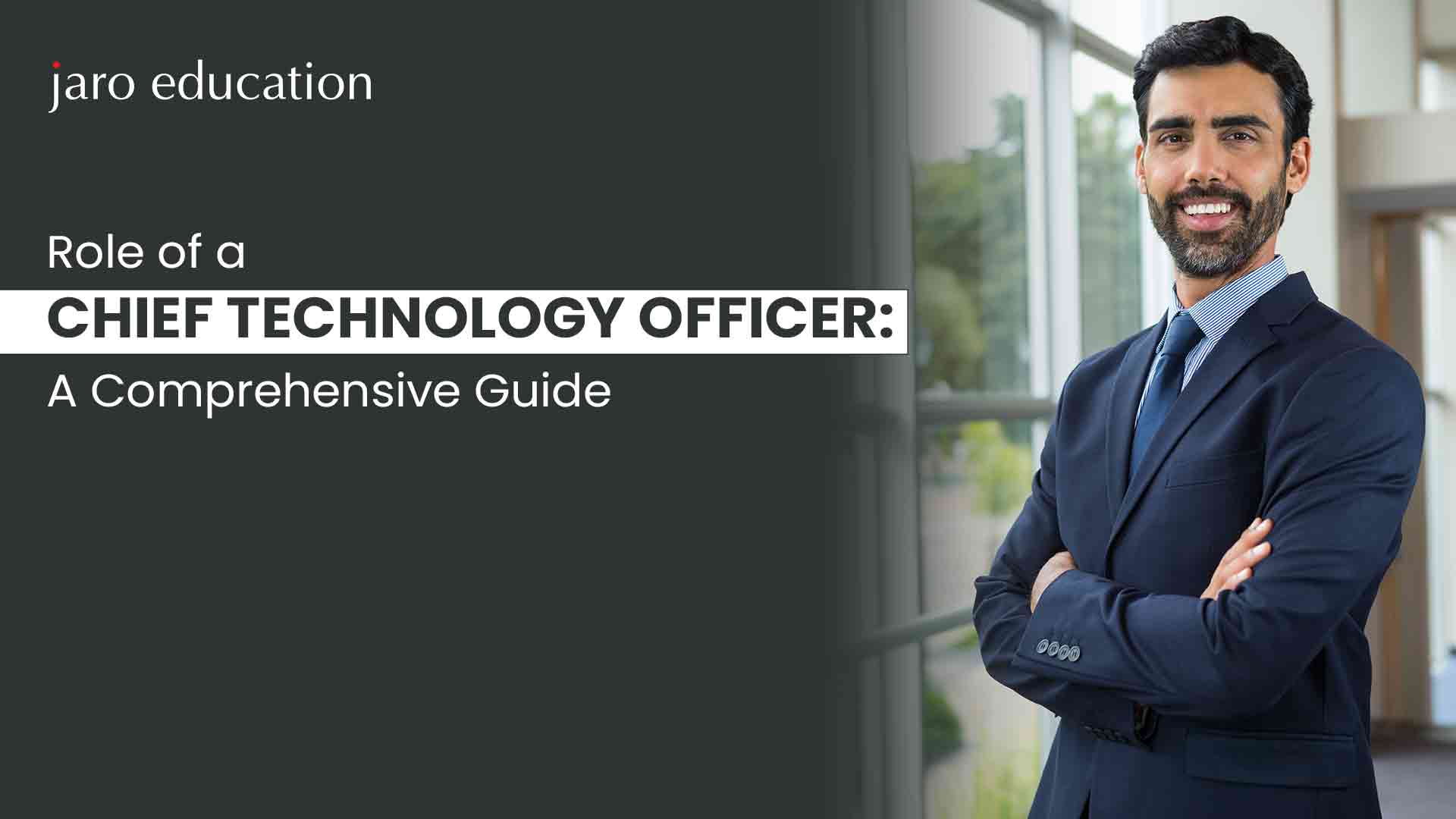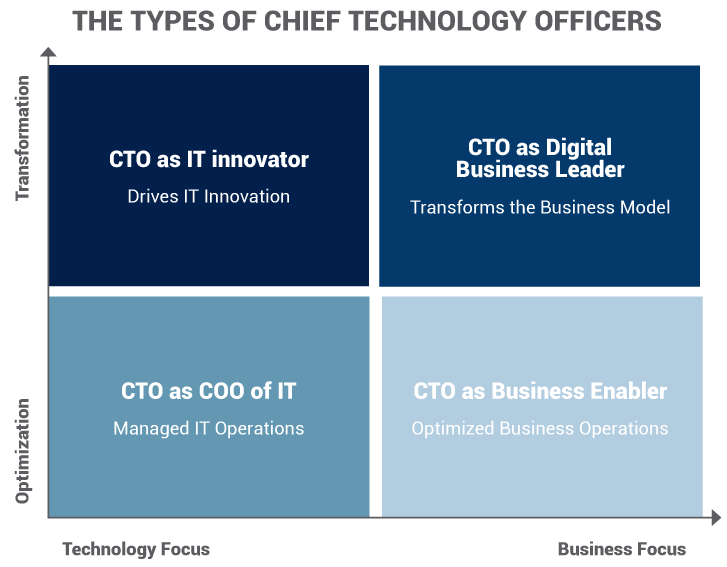Role of a Chief Technology Officer: A Comprehensive Guide
Table of Contents

- jaro education
- 4, March 2024
- 10:00 am
The role of a Chief Technology Officer (CTO) is to ensure that technological strategies seamlessly align with the overarching goals of a company. A CTO’s responsibilities extend beyond overseeing IT departments or help desks. They leverage their expertise in both existing and emerging technologies to furnish businesses with optimal solutions geared for the future.
Chief Technology Officers (CTOs) are executive leaders responsible for guiding organizations in the development, implementation, and upkeep of their technology systems and processes. This role offers a blend of challenges and rewards, presenting the chance for lucrative earnings and the ability to enhance an organization’s innovation capabilities. If you possess a passion for technology coupled with leadership experience, a career as a CTO might be intriguing.
This blog aims to elucidate the role of a CTO, delve into associated job duties, provide insights into the average CTO salary package, and offer guidance on the path to becoming one.
WhO is a Chief Technology Officer (CTO)?
The Chief Technology Officer (CTO) is the executive entrusted with steering an organization’s technological side and spearheading Research and Development (R&D) initiatives. Beyond a mere oversight role, the CTO meticulously assesses both short and long-term organizational needs, strategically allocating capital to make investments that propel the company toward its objectives.
Historically, the dual role of Chief Information Officer (CIO) encompassed both technological and information management responsibilities. However, as technological advancements accelerated, the necessity to bifurcate these roles became apparent, leading to the inception of the distinct CTO position. Distinguishing between the two roles illuminates their complementary yet distinct functions. While the CIO undertakes a technology-centric, operational role, the CTO adopts a more outward-looking, strategically oriented stance.
In the organizational hierarchy, the CTO typically reports directly to the Chief Information Officer (CIO). However, depending on the company’s structure, the CTO might also report directly to the Chief Executive Officer (CEO). This dynamic position requires a forward-thinking individual who can navigate the intricate intersection of technology, business strategy, and innovation. The CTO’s strategic decisions play a pivotal role in shaping the technological infrastructure, ensuring alignment with the organization’s goals and fostering a culture of innovation and adaptability.
Tailored for seasoned tech professionals the “Chief Technology Officer Programme – offered by CEP, IIT Delhi” guides participants through the intricate intersection of technology, business strategy, and innovation. This Chief Technology Officer course empowers participants to advance their careers by developing a deep understanding of technology leadership. With insights from industry experts, this course fosters innovation, ensuring that decisions mould technological infrastructure in alignment with organizational goals.
The Role of Chief Technology Officer
The Chief Technology Officer (CTO) emerges as the paramount technology executive, wielding influence over the technology and engineering echelons within a company. The role of a Chief Technology Officer (CTO) is intricately shaped by the unique characteristics of each company, considering its history, specific positions previously held, and the demands of its industry.
At the core of the CTO’s responsibilities is the imperative to envision how technology can be optimally utilized within the company, aligning this vision with overarching organizational goals. This involves delineating company objectives and establishing clear timelines for research and development initiatives, ensuring a strategic roadmap for technological progress. The CTO is tasked with developing the technical aspects of the company’s strategy, orchestrating a seamless alignment with overarching business goals to facilitate sustained growth.
Resource optimization is a crucial facet of the CTO’s role, necessitating a keen focus on ensuring that technological resources meet both short and long-term organizational needs. Innovation integration is another key responsibility, requiring the identification and implementation of cutting-edge technologies that confer a competitive advantage and position the company at the forefront of technological advancements. Beyond technical expertise, the CTO engages in strategic mentorship, aiding various departments in leveraging technology profitably and serving as a mentor to team members, thereby fostering a collaborative and learning-oriented environment.
Types of Chief Technology Officers
Chief Technology Officers (CTOs) have assumed pivotal roles, each tailored to address specific business requirements. The responsibilities and focus areas of CTOs have given rise to distinct archetypes within this essential leadership position:

*harbhot.com
1. Technology Visionary CTO
The Technology Visionary CTO assumes a pivotal role in shaping and articulating the organization’s long-term technology strategy. With a keen focus on envisioning the future, this CTO is dedicated to implementing innovative solutions that drive sustained growth. Key skills defining success in this role include proficiency in strategic planning, a deep understanding of emerging trends, and the ability to foster a culture of innovation within the organization. This CTO archetype plays a crucial part in steering the technological trajectory of the company toward greater heights.
2. Product-Centric CTO
The Product-Centric CTO assumes a pivotal role in integrating technology seamlessly into the development of products and services. With a primary focus on enhancing and aligning products with market demands, this CTO archetype possesses key skills in product development, conducting market research, and adeptly integrating technology to meet the evolving needs of the market. By strategically merging technology and product development, this CTO contributes significantly to the company’s ability to deliver innovative and market-responsive offerings.
3. Infrastructure Guru CTO
The Infrastructure Guru CTO takes charge of managing and optimizing the technology infrastructure within an organization. With a keen focus on ensuring a robust and scalable technology backbone, this CTO archetype brings essential skills in system architecture, cybersecurity, and infrastructure optimization to the table. By expertly overseeing the technological framework, the Infrastructure Guru CTO plays a crucial role in maintaining the reliability, security, and efficiency of the organization’s overall technological infrastructure.
4. Engineering Maestro CTO
The Engineering Maestro CTO assumes a pivotal role in guiding and leading the engineering and development teams within an organization. With a primary focus on optimizing software and hardware development processes, this CTO archetype brings essential skills in technical expertise, team leadership, and project management. By leveraging a deep understanding of engineering principles, the Engineering Maestro CTO contributes to the efficient and innovative advancement of the organization’s technological capabilities, ensuring the seamless integration of cutting-edge solutions into the overall business strategy.
How to Become a Chief Technology Officer (CTO)
The journey to becoming a Chief Technology Officer (CTO) is a strategic endeavor that integrates education, hands-on experience, and specialized skills. Aspiring individuals chart a deliberate course to attain this pinnacle position in technology leadership. The following steps delineate the key considerations for those with aspirations of becoming a CTO:
1. Educational Foundation
The steps to become a Chief Technology Officer (CTO) begin with a bachelor’s degree in technology-focused fields like computer science or engineering. This foundational education is often complemented by advanced degrees, such as master’s or Ph.D. qualifications, underscoring a commitment to continuous learning and deepening expertise.
Enrolling in specialized courses like the “Chief Technology Officer Programme Offered by CEP, IIT Delhi” can further augment one’s journey towards achieving the CTO role. This course not only equips participants with advanced technical knowledge but also fosters a holistic understanding of strategic leadership in the technology domain.
For aspiring CTOs, this educational journey serves as a springboard, providing the essential knowledge and skills needed for technology leadership. It forms the basis upon which they cultivate strategic insights and innovative approaches, positioning themselves for leadership excellence in the technology sector.
2. Gain Practical Experience
To lay a robust foundation for a Chief Technology Officer (CTO) role, active engagement in hands-on positions is essential. Roles in software development, systems administration, or technical project management contribute significantly to a well-rounded skill set. These experiences not only provide practical exposure to technology applications but also foster a deep understanding of their real-world implications. Such hands-on involvement is crucial for aspiring CTOs, offering the expertise and insights necessary for effective leadership.
3. Develop Leadership Skills
Cultivating leadership skills is a pivotal step toward a Chief Technology Officer (CTO) role. Transitioning into leadership positions provides the necessary experience to develop essential skills like strategic thinking, effective decision-making, and proficient team management. Leadership is a cornerstone for a CTO, as the role typically involves overseeing technology teams and making strategic contributions to the organization’s overall direction. This experience not only shapes a well-rounded leader but also prepares individuals for the responsibilities associated with technology leadership.
4. Stay Updated on Technology Trends
Remaining current with technology trends is paramount for aspiring Chief Technology Officers (CTOs). The dynamic nature of technology demands constant awareness of the latest trends and advancements. Actively participating in conferences, attending webinars, and engaging in continuous learning are essential strategies to stay at the forefront of technological developments.
This commitment to staying informed not only demonstrates a dedication to professional growth but also equips individuals with the knowledge needed to lead technology initiatives effectively, aligning them with the organization’s goals and ensuring adaptability in the ever-evolving tech landscape.
5. Network and Build Professional Relationships
Building a strong professional network is a strategic move for aspiring Chief Technology Officers (CTOs) in the technology industry. Cultivating relationships with peers, mentors, and industry experts provides invaluable opportunities for learning and growth. Networking serves as a gateway to potential leadership opportunities, opening doors to roles that align with career goals.
A robust professional network not only enhances knowledge exchange but also fosters collaboration, creating a supportive ecosystem where individuals can share insights, seek advice, and stay informed about industry trends—essential elements for success in the field of technology leadership.
6. Consider Advanced Certifications
Considering advanced certifications is a strategic move for aspiring Chief Technology Officers (CTOs). Pursuing certifications that validate expertise in specific technologies or methodologies, such as Certified Information Systems Security Professional (CISSP) or Project Management Professional (PMP), adds significant value to a CTO’s professional profile. These certifications not only enhance credibility but also demonstrate a commitment to continuous learning and mastery of essential skills.
Salary and Job Outlook of Chief Technology Officer
As per Glassdoor, Chief Technology Officer (CTO) salary in India is somewhere around ₹31,37,500, with an additional cash compensation averaging ₹3,87,500. The range for additional cash compensation varies widely, spanning from ₹1,00,000 to ₹15,00,000. These salary figures are derived from an analysis of 538 anonymously submitted salaries to Glassdoor by Chief Technology Officer (CTO) professionals across India.
CIO vs. CTO What is the Difference?
| Aspect | Chief Information Officer (CIO) | Chief Technology Officer (CTO) |
|---|---|---|
| Focus | Internal operations, IT strategy, and implementation | External processes, broader technology infrastructure |
| Responsibilities | Overseeing technology architecture Maintaining technology infrastructure Optimizing technology resources (software, hardware, staff, budget) Researching and evaluating existing and emerging technologies | Developing marketable technology. Suggesting new technologies to implement Interacting with external buyers and budgeting Handling customer experience, support, and front-end c/brontent delivery Focusing on revenue enhancement and sales opportunities Extending the company brand through innovative technologies. |
| Skill Set | Analytical skills for internal IT processes | Marketing skills for external stakeholder engagement |
| Relationship Building | Internal collaboration with IT staff | External engagement with vendors, customers, investors, partners |
| Reporting Structure | Often reports to the CEO or another executive | Typically reports to the CIO |
| Technical Knowledge and Expertise | Balanced technical knowledge and expertise | Typically possesses more technical expertise |
| Alignment with Business Objectives | Designing and recommending appropriate technology strategies | Collaborating on broader technological governance |
Conclusion
Contrary to common misconceptions, a CTO’s responsibilities extend beyond overseeing internal IT operations, encompassing a broader perspective that aligns technology with external processes and organizational goals. As technology continues to evolve, the diverse archetypes of CTOs—whether visionary, product-centric, infrastructure guru or engineering maestro—emerge to address specific business needs.
The journey to becoming a CTO is marked by a deliberate blend of education, hands-on experience, leadership cultivation, and continuous skill development. A strong educational foundation, coupled with practical experience and leadership roles, forms the bedrock for aspiring CTOs. Staying abreast of technology trends, building a robust professional network, specializing in key domains, and obtaining advanced certifications contribute to a well-rounded skill set.






